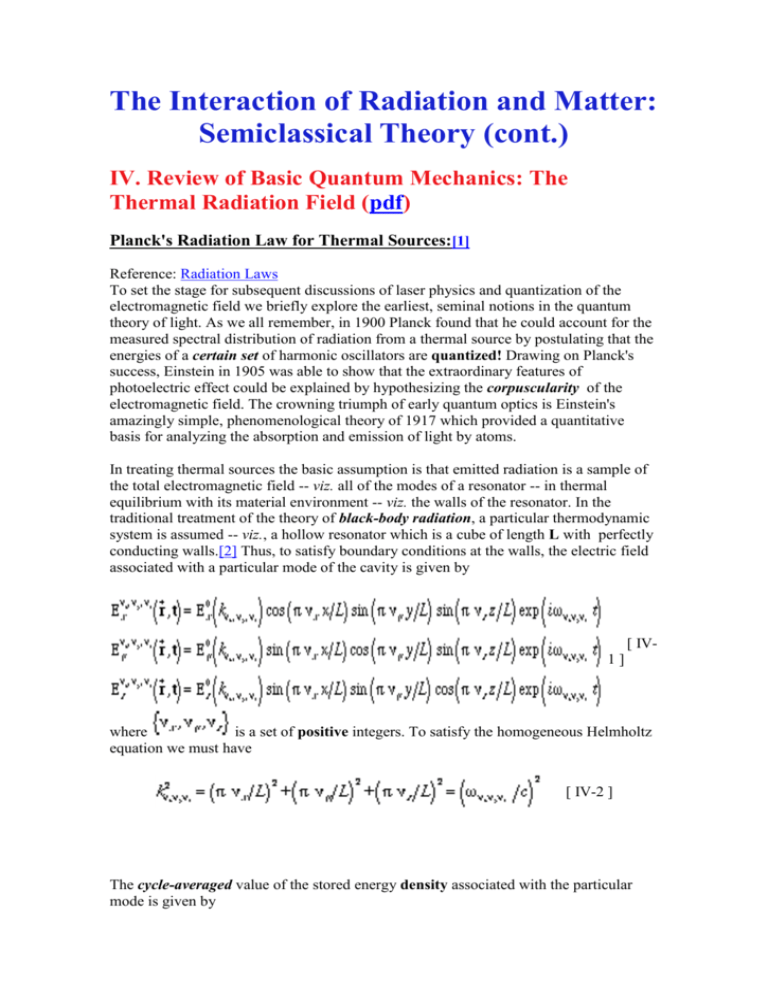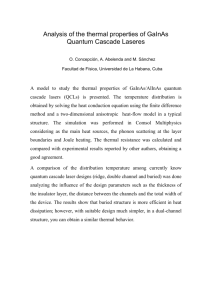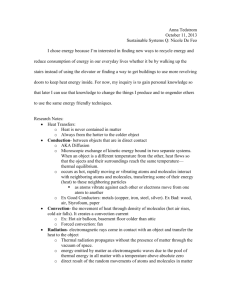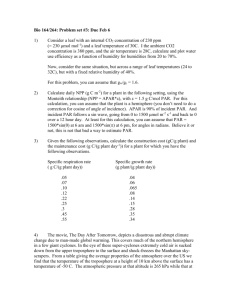The Interaction of Radiation and Matter: Semiclassical Theory (cont
advertisement

The Interaction of Radiation and Matter: Semiclassical Theory (cont.) IV. Review of Basic Quantum Mechanics: The Thermal Radiation Field (pdf) Planck's Radiation Law for Thermal Sources:[1] Reference: Radiation Laws To set the stage for subsequent discussions of laser physics and quantization of the electromagnetic field we briefly explore the earliest, seminal notions in the quantum theory of light. As we all remember, in 1900 Planck found that he could account for the measured spectral distribution of radiation from a thermal source by postulating that the energies of a certain set of harmonic oscillators are quantized! Drawing on Planck's success, Einstein in 1905 was able to show that the extraordinary features of photoelectric effect could be explained by hypothesizing the corpuscularity of the electromagnetic field. The crowning triumph of early quantum optics is Einstein's amazingly simple, phenomenological theory of 1917 which provided a quantitative basis for analyzing the absorption and emission of light by atoms. In treating thermal sources the basic assumption is that emitted radiation is a sample of the total electromagnetic field -- viz. all of the modes of a resonator -- in thermal equilibrium with its material environment -- viz. the walls of the resonator. In the traditional treatment of the theory of black-body radiation, a particular thermodynamic system is assumed -- viz., a hollow resonator which is a cube of length L with perfectly conducting walls.[2] Thus, to satisfy boundary conditions at the walls, the electric field associated with a particular mode of the cavity is given by [ IV1] where is a set of positive integers. To satisfy the homogeneous Helmholtz equation we must have [ IV-2 ] The cycle-averaged value of the stored energy density associated with the particular mode is given by [ IV-3 ] For a thermal source, the most significant experimentally measurable object is the noise spectrum -- i.e., the frequency distribution of the stored energy density. To obtain this distribution, we take the energy density in the frequency range between -- viz. and [ IV-4 ] Thus the density of states is defined as [ IV-5a ] In the frequency range where , the following k-space argument holds: [ IV-5b ] This extremely important density-of-states construction may be visualized most elegantly in two dimensions. [3] Following the traditional (Rayleigh-Jeans) argument, we identify a resonator mode as a harmonic oscillator [4] and take its average energy to be the classical thermodynamic value for a system with two degrees of freedom -- i.e. Thus, we obtain the famous Rayleigh-Jeans radiation law (which impels us to worry about an ultra-violet catastrophe.) [ IV-6 ] Planck's quantization hypothesis: Following Planck we set [ IV-7 ] where n = 0, 1, 2,...... Assuming that the resonator mode is in thermal equilibrium with its environment, we may use the Boltzmann probability factor to find the probability energy that the mode (read oscillator) is thermally excited to an [ IV8] The thermal mean value of n is obtained in a similar manner [5] -- viz. [ IV-9 ] which may be plotted Equation [ IV-9 ] taken in conjunction with Equations [ IV-5b ] and [ IV-7 ] leads then directly to the Planck radiation law [ IV-10 ] From this expression we see that the Rayleigh-Jeans radiation law is correct in the limit , but, to our great relief, Planck has staved off the ultraviolet catastrophe. We may then plot this famous and an exceedingly important result. (From the particular point view of laser physics, the Planck radiation law gives a measure of the background radiative thermal noise spectrum.) Einstein's Phenomenological Theory of Radiation Processes -- Einstein's "A" and "B" coefficients: We return to the two-level system and, with Einstein, make some physically reasonable (early quantum mechanical) postulates concern the absorption and emission of light. Consider the two-level system shown below. Einstein's postulates [6] are embodied in a set of rate equations for the level populations- viz. [ IV-11 ] It particularly useful to examine the results of these equations under conditions -- viz. General equilibrium or steady-state condition: [ IV-12a ] Thermal equilibrium condition: [ IV-12b ] Of course, in the latter case we use fact that the level populations equilibrium are related by Boltzmann's law -- i.e. and at thermal [ IV-13 ] so that [ IV-14 ] Thus, by comparison with Equation [ IV-10 ], we see that [ IV-15a ] and [ IV-15b ] and, by comparison with Equation [ IV-9 ], we see that [ IV-16a ] or [ IV-16b ] [1] This section and some parts of the following section draw heavily upon discussions in Rodney Loudon's The Quantum Theory of Light (2nd edition), Oxford (1983). [2] The detail results of black-body radiation theory are indeed sensitive to the assumed character of the thermodynamic systems will be demonstration presently. [3] For use in later discussions, we note here that by this same argument the 2D densityof-states is found to be and the 1D value . [4] We justify this assertion in detail later: it suffices to note here, in anticipation of that later discussion, that a harmonic oscillator and an electromagnetic mode have analogous Hamiltonians. [5] It is also easy to show that thermal mean-square fluctuation in n is given by . [6] Using our semiclassical theory of matter-radiation interaction, we can easily show that but, of course, Einstein did not have that well-developed theory at hand. While the stimulated emission and absorption processes are reasonably intuitive, it is the introduction of the spontaneous emission process which flows from a profound understanding of the processes by which thermal equilibrium is achieved. Back to top This page was prepared and is maintained by R. Victor Jones, jones@deas.harvard.edu Last updated March 9, 2000









